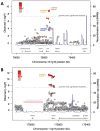ImmunoChip study implicates antigen presentation to T cells in narcolepsy
- PMID: 23459209
- PMCID: PMC3573113
- DOI: 10.1371/journal.pgen.1003270
ImmunoChip study implicates antigen presentation to T cells in narcolepsy
Abstract
Recent advances in the identification of susceptibility genes and environmental exposures provide broad support for a post-infectious autoimmune basis for narcolepsy/hypocretin (orexin) deficiency. We genotyped loci associated with other autoimmune and inflammatory diseases in 1,886 individuals with hypocretin-deficient narcolepsy and 10,421 controls, all of European ancestry, using a custom genotyping array (ImmunoChip). Three loci located outside the Human Leukocyte Antigen (HLA) region on chromosome 6 were significantly associated with disease risk. In addition to a strong signal in the T cell receptor alpha (TRA@), variants in two additional narcolepsy loci, Cathepsin H (CTSH) and Tumor necrosis factor (ligand) superfamily member 4 (TNFSF4, also called OX40L), attained genome-wide significance. These findings underline the importance of antigen presentation by HLA Class II to T cells in the pathophysiology of this autoimmune disease.
Conflict of interest statement
The authors have declared that no competing interests exist.
Figures


References
-
- Mignot E (1998) Genetic and familial aspects of narcolepsy. Neurology 50: S16–22. - PubMed
-
- Han F, Lin L, Warby SC, Faraco J, Li J, et al. (2011) Narcolepsy onset is seasonal and increased following the 2009 H1N1 pandemic in China. Annals of neurology 70: 410–417. - PubMed
-
- Partinen M, Saarenpaa-Heikkila O, Ilveskoski I, Hublin C, Linna M, et al. (2012) Increased incidence and clinical picture of childhood narcolepsy following the 2009 H1N1 pandemic vaccination campaign in Finland. PLoS ONE 7: e33723 doi:10.1371/journal.pone.0033723. - DOI - PMC - PubMed
Publication types
MeSH terms
Substances
Grants and funding
LinkOut - more resources
Full Text Sources
Other Literature Sources
Medical
Research Materials

